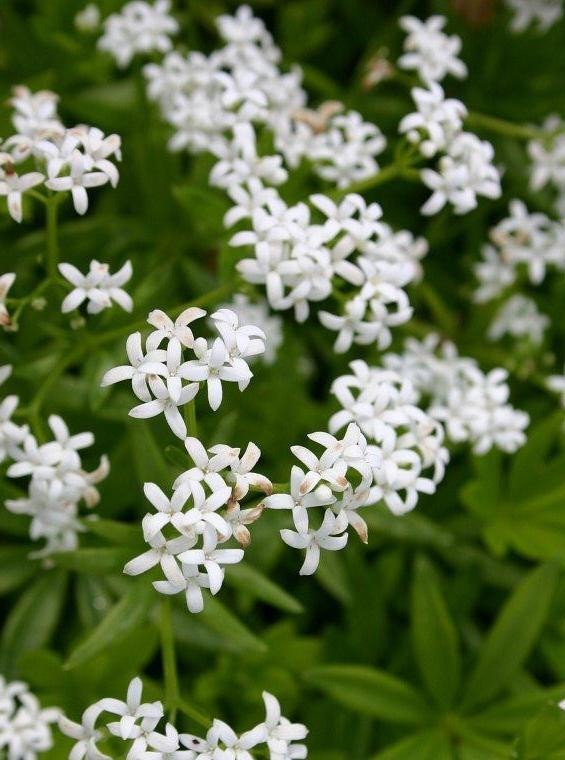Sweetscented Bedstraw
(Galium odoratum)

Description
Galium odoratum, the sweet woodruff or sweetscented bedstraw, (Syn: Asperula odorata) is a flowering perennial plant in the family Rubiaceae, native to much of Europe from Spain and Ireland to Russia, as well as Western Siberia, Turkey, Iran, the Caucasus, China and Japan. It is also sparingly naturalized in scattered locations in the United States and Canada. It is widely cultivated for its flowers and its sweet-smelling foliage. The leaves are simple, lanceolate, glabrous, 2–5 cm (0.79–1.97 in) long, and borne in whorls of 6–9. The small (4–7 mm diameter) flowers are produced in cymes, each white with four petals joined together at the base. The fruits are 2–4 mm diameter, produced singly, and each is covered in tiny hooked bristles which help disperse them by sticking temporarily to clothing and animal fur. This plant prefers partial to full shade in moist, rich soils. In dry summers it needs frequent watering. Propagation is by crown division, separation of the rooted stems, or digging up of the barely submerged perimeter stolons. It is ideal as a groundcover or border accent in woody, acidic gardens where other shade plants fail to thrive. Deer and chickens avoid eating it (Northeast US). As the epithet odoratum suggests, the plant is strongly scented, the sweet scent being derived from coumarin. This scent increases on wilting and then persists on drying, and the dried plant is used in potpourri and as a moth deterrent. It was, and partially is, used to flavour May wine (called "Maibowle" or "Maitrank" in German), sweet juice punch, syrup for beer (Berliner Weisse), brandy, jelly, jam, a soft drink (Tarhun, which is Georgian), ice cream, and herbal tea. Also very popular are sweet woodruff flavoured jellies, with and without alcohol. In Germany, it was also used to flavour sherbet powder, which features prominently in Günter Grass' novel The Tin Drum. However, the usage of the plant for sweets was prohibited in Germany in 1974, due to the plant's low level toxicity, which increases upon drying, and is particularly problematic for children, due to their lower body mass. The toxicity stems from the presence of coumarin, which can create sickness, headaches, and damage the liver when ingested in greater quantities. The flavour is still popular for sweets in Germany, but is achieved artificially with other flavouring agents. Products targeted towards adults, such as alcoholic drinks, are still permitted to include coumarin, in limited quantities.
Taxonomic tree:







